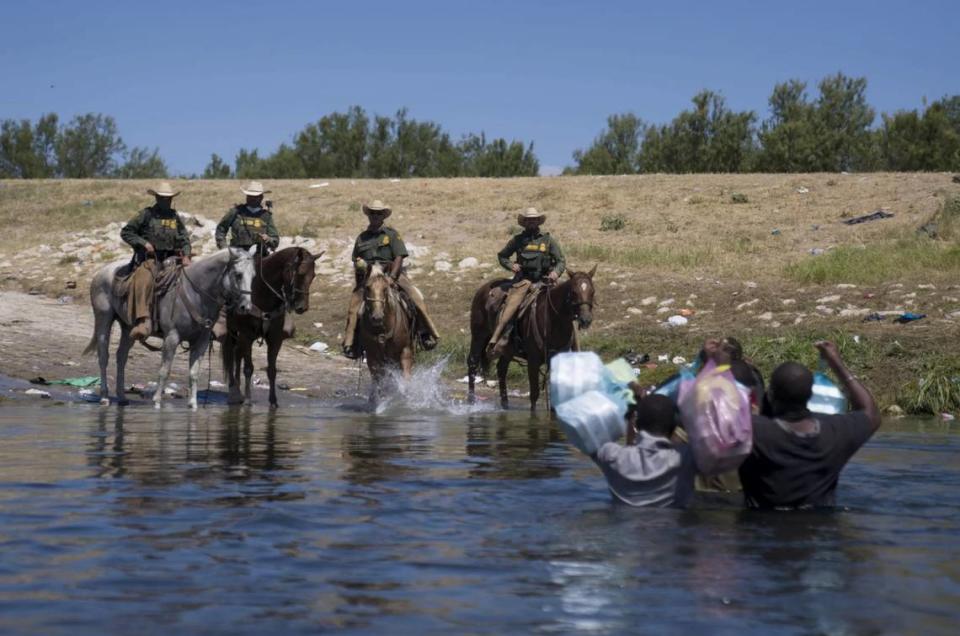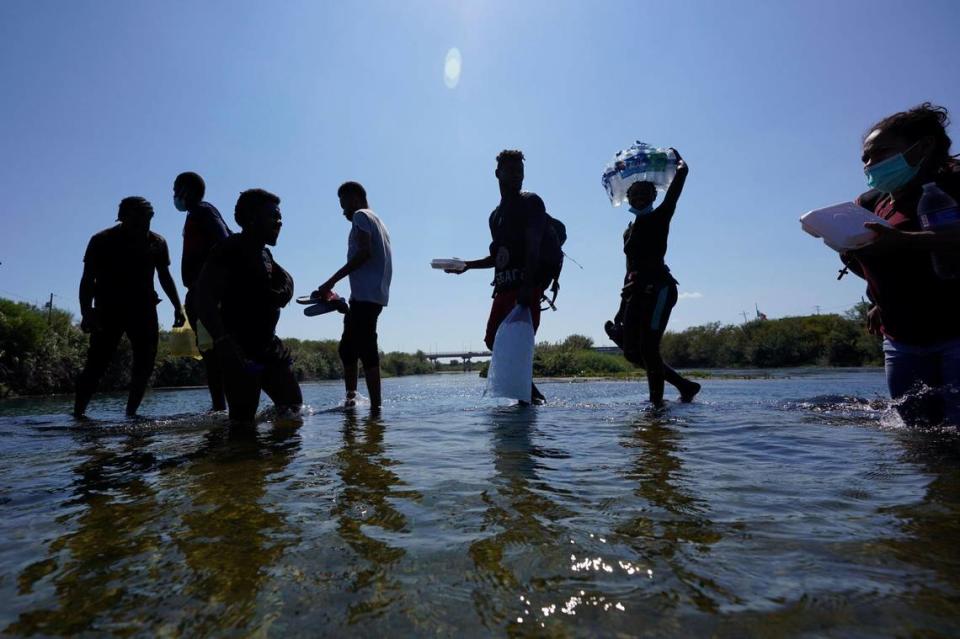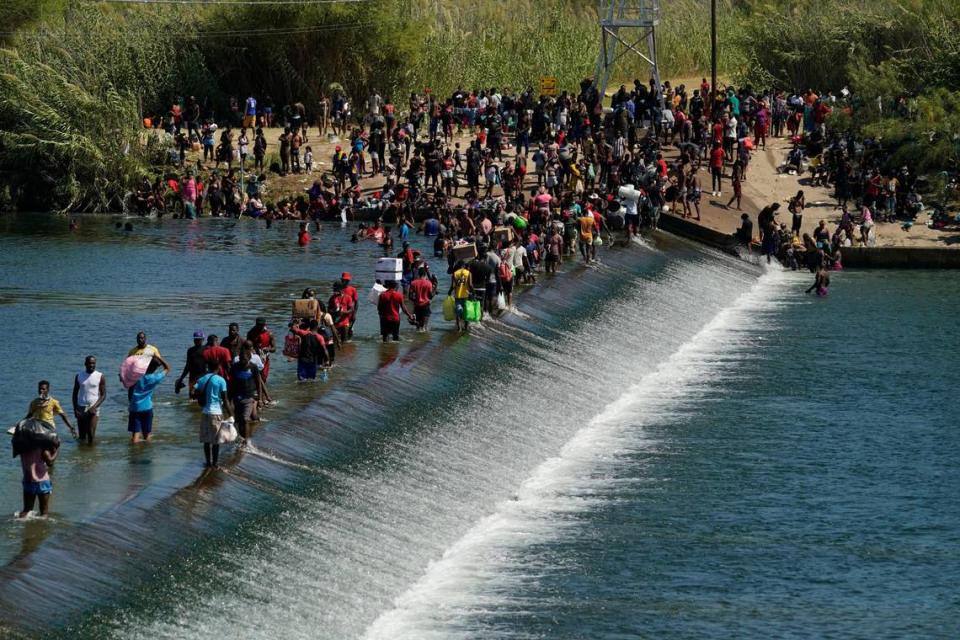Image of agent on horseback is reminder of U.S. immigration mistreatment, Haitians say
The image of a U.S. border agent on horseback wielding what appears to be a rope or reins while chasing a Haitian migrant on the U.S.-Mexico border first appeared on Rulx Jean-Bart’s telephone as a WhatsApp video being shared by outraged fellow Haitians.
Jean-Bart, a former director of what was once the largest Haitian rights organization who now lives in Miramar, said the image instantly took him back several decades.
It didn’t matter if the agent was holding a lariat or horse reins or if the migrant was actually struck or not. The picture was enough.
“It reminded me of our history here in the United States. There has always been this mistreatment of Haitians, treating them differently; keeping them away from the U.S. at any cost,” said Jean-Bart, calling the image “painful and revolting.”
“Whether it was under [the Duvalier regime], or any other president,” he said, “it has always been the same story.”
The video of a mounted U.S. Border Patrol agent chasing a Haitian migrant, who falls back into the Rio Grande, was taken on the U.S. side of the border in Del Rio, Texas, and has appeared on U.S. news sites and on social media since early Monday.
It has sparked outrage across communities, and condemnation of the Biden administration even by Democrats.
“The images of this unconscionable attack by United States border agents on helpless Haitian migrants have an uncanny resemblance to the photos in our history books that show the truth of how Black people were treated in this country in centuries past,” said U.S. Rep. Maxine Waters, a California Democrat who has long been an outspoken supporter of Haitians.
Waters said she is “outraged by the reprehensible behavior of these border agents who seem to lack humanity,” and “extremely disappointed in the Biden Administration for its willingness to continue the racist application of immigration policies and tactics utilized by Donald Trump, the most xenophobic and dangerous president in our nation’s history.”
White House Press Secretary Jen Psaki, speaking to reporters aboard Air Force One on Tuesday, said President Joe Biden had seen the footage and photo and believes they “are horrific.”
“He believes this does not represent who we are as a country and does not represent the positions of the Biden-Harris administration,” she added.

Haitian refugees first began arriving on U.S. shores by boat in the 1970s, pushed by their homeland’s political turmoil and the repressive regime of the nearly three-decade Duvalier dictatorship. But as they arrived in Florida, often in rickety boats, they were often jailed, denied asylum and branded as economic immigrants. They were swiftly expelled by Republican and Democrat administrations alike that refused to recognize the repression in Haiti.
More than four decades later, many of those early refugees who did manage to stay are today the parents and grandparents of American-born offspring who are doctors, lawyers and other professionals. Some have even been elected to political office. But the struggle of Haitians continues, they say, as U.S. immigration policy continues to show a double standard.
“This is not the first time immigration, border patrol agents and the police have unleashed horses and dogs on us,” said Marleine Bastien, recalling her days as a young activist demanding justice and equal treatment for Haitians in front of the Krome Detention Center in South Miami-Dade County and the Haitian Refugee Center, where Jean-Bart worked, in Little Haiti.
“Let it be clear, they did it in front of the Krome Detention Center, in front of the Haitian Refugee Center on 54th Street,” she added. “The U.S. has a long history of abusing Haitian refugees and trampling on their rights of due process.”
New migration: Haitians carve a dangerous 7,000-mile path to the U.S.
A reminder of historic grave abuses, the video has also reminded Black Americans and others of slave patrols, when enslaved Africans were chased by men on horses as they tried to run away from their white masters.
Bastien, founder of the Family Action Network Movement, which many newly arrived refugees turn to for help, said Haitian community leaders in Miami are not only demanding a swift investigation into the incident, they want the agent fired.
“This is abuse. This border patrol officer needs to be arrested,” she said.
Vice President Kamala Harris, who is Black and is in charge of addressing the root causes of migration for the Biden administration, said Tuesday what she saw on the video is “horrible” and added she fully supports the investigation launched by Department of Homeland Security Secretary Alejandro Mayorkas.
“Human beings should never be treated that way. And I’m deeply troubled about it,” Harris said, adding that she plans to speak to Mayorkas.
Mayorkas, who in an interview with CNN refrained from saying whether what happened was mistreatment or abuse, on Tuesday told a U.S. Senate Committee on Homeland Security & Governmental Affairs that an investigation has begun at his direction by the Office of Professional Responsibility within the DHS’ Customs and Border Protection.
“I directed that the Office of Professional Responsibility be present on site in Del Rio 24/7 to ensure that the conduct of our personnel adheres to our policies, to our training, and to our values,” said Mayorkas, adding that he was “horrified to see the images.” He said late Tuesday that he anticipates having the results of the investigation by the end of next week and will make them public.
As Chile prepares for new president, Haitians warned they won't find 'paradise' there
During the testimony, Mayorkas said what he saw during a visit Monday under the Del Rio International Bridge, where an estimated 15,000 Haitian migrants had gathered, was “the acute vulnerability of the Haitian population, the predominantly Haitian population, and I cannot overstate how difficult that is to see. We are speaking about vulnerable individuals in tragic circumstances.”
“I also saw the extraordinary work of U.S. Customs and Border Protection, not only the United States Border Patrol, but its office of field operations as well as other agencies within the Department of Homeland Security that have been surged to Del Rio to address the situation in partnership with state and local law enforcement personnel,” he added.

Mayorkas has repeatedly said that Haitian migrants are being led to Del Rio by false information, and defended the accelerated repatriation of Haitians from the border.
“We’re hoping that what we are doing now serves as a deterrent, because it backs up the words that we have spoken from the very outset: that irregular migration is not the way to enter the United States, it will not work, it is dangerous, and it creates a humanitarian challenge,” he told the Senate panel. “We expect to see dramatic results in the next 48 to 96 hours, and we’ll have a far better sense in the next two days.”
The U.N. High Commissioner for Refugees called on the U.S. government Tuesday to immediately lift its Title 42 restrictions, saying the public-health law, in effect since the early days of the COVID-19 pandemic in March 2020, denies most people arriving at the southwestern U.S. border any opportunity to request asylum. The law allows the U.S. government to expel any arriving migrant who has been in a country where a communicable disease is present.
“Mass expulsions of individuals currently under way under the Title 42 authority, without screening for protection needs, is inconsistent with international norms,” Filippo Grandi said.
Allegations of mistreatment by U.S. immigration agents is not new, and it has often underscored the strained and oftentimes tense relationship between Haitian migrants and U.S. immigration officials. Nowhere has that been more apparent than in Miami, where the difference in treatment between Haitian and Cuban refugees was most stark with the introduction of the Clinton administration policy that came to be known as “wet foot, dry foot.”
Before it was ended by the Obama administration in 2017, the policy dictated that Cubans interdicted at sea had to be returned but those who touched U.S. soil could stay and later apply for residency. Haitians and other migrants, however, were not afforded the same benefit and were detained and sent back to their country of origin.
And then there is the U.S. Guantánamo Bay Naval Base in Cuba.
Before the base became a maximum-security prison camp for terror suspects and hunger strikers, it housed thousands of Haitians who had fled the violence following the coup by a military junta that deposed Haiti’s president in 1991. Among the migrants were 213 unaccompanied Haitian children who languished in detention for months before many were eventually sent back to Haiti.
“They had 60,000 Haitians in Guantánamo Bay; 12,000 were eventually paroled in,” said Randy McGrorty, executive director of Catholic Legal Services. “But going back further with Mariel, they had 125,000 Cubans in six weeks and 25,000 Haitians. People forgot that.”
Mariel refers to the 1980 Mariel Boatlift, where again Cubans benefited almost immediately from U.S. immigration policy and Haitian advocates were forced to fight for relief before finally getting it under new legislation.
“It’s not the first time we’ve seen this many migrants and it won’t be the last time,” McGrorty said of the Haitians under the bridge in Del Rio. “With other groups, we seem to process them through, but with Haitians we seem to take a hardcore approach.”
Guerline Jozef, who co-founded the Haitian Bridge Alliance after the last Haitian migration crisis at the border, said the unequal and discriminatory treatment of Black migrants, especially Haitians, must end.
Like Bastien, she called for an end to the use of Title 42, which is being used by the Biden administration to deport Haitians to Haiti without a chance to state a claim for asylum in the U.S.

Recalling when the U.S. Centers for Disease Control and Prevention described Haitians as being one of the “Four H” groups at risk of contracting and spreading HIV/AIDS — “homosexuals, heroin users, hemophiliacs, and Haitians” — Jozef said anti-Black racism “is continuing to guide the country and the principle of the immigration system.”
“We cannot stand back and watch the United States repeat the same injustice they made toward the Haitian community,” she said. “As President Biden continues to talk about Build Back Better, this is one of the points that he needs to really look into and start to Build Back Better from there. They continue to repeat history; that history that continues to destroy Black lives is unacceptable.”
Bastien said there are political implications for the Democratic Party as younger generations of Haitians look more closely at the issue and the Biden administration’s use of Title 42.
“Young voters are telling me that they are becoming independent,” she said.
And while the struggle for Haitian migrants continues 40 years after the first boatloads of Haitians washed up on South Florida’s shores, Bastien said, “there is a difference between 1981 and 2021.”
“Today, we have the power of our votes.”

 Yahoo Movies
Yahoo Movies 